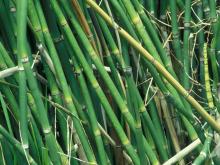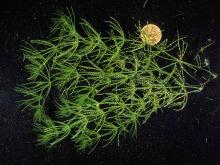Wildflowers, Grasses and Other Nonwoody Plants
Media

Species Types
Scientific Name
Microstegium vimineum
Description
Japanese stiltgrass is an invasive annual grass with thin, pale green, lance-shaped leaves that are 3 inches long. It has spread to nearly every eastern U.S. state. It forms dense patches, displacing and outcompeting native species for nutrients and light.
Media

Species Types
Scientific Name
Equisetum (3 spp. in Missouri)
Description
Horsetails, or scouring rushes, are in the genus Equisetum. They’re easy to recognize with their jointed, hollow stems. Like ferns, they reproduce via spores instead of flowers and seeds.
Media

Species Types
Scientific Name
Camassia scilloides
Description
In spring, wild hyacinth bears an elongated cluster of pale blue flowers with prominent anthers that sway on stalks up to 2 feet tall.
Media

Species Types
Scientific Name
Solidago spp. (23 species in Missouri)
Description
There are 23 species of goldenrods in Missouri. They can be hard to identify to species, but as a group, the goldenrods are common and nearly unmistakable.
Media

Species Types
Scientific Name
Typha spp.
Description
Missouri’s cattails are all tall wetland plants with narrow, upright leaves emerging from a thick base, and a central stalk bearing a brown, sausage-shaped flower spike.
Media

Species Types
Scientific Name
Potamogeton spp.
Description
Pondweeds are rooted aquatic plants with underwater leaves on long, flexible, jointed stems. Some have floating leaves, too, that are differently shaped. Missouri has about 10 species in the pondweed genus.
Media

Species Types
Scientific Name
Chara spp.
Description
These aquatic algae look like regular vascular plants. Chara has a crisp, gritty texture, a musky odor, and gray-green, needlelike structures that resemble leaves.
Media

Species Types
Scientific Name
Symphyotrichum pilosum (formerly Aster pilosus)
Description
White heath aster is one of Missouri's most widespread and weedy native asters. It grows in uplands, bottomlands, and nearly all habitats in between. It has a shrubby, wide-branching habit, and the stem leaves are thin and needlelike.
Media

Species Types
Scientific Name
Sorghum halepense
Description
Johnson grass is a native of the Mediterranean that is invasive in our country. It’s a weed that infests cropland and degrades native ecosystems, and heavy infestations are found in all the major river bottoms of Missouri.
Media

Species Types
Scientific Name
All true grasses (species in the grass family)
Description
Missouri has 276 species in the grass family, including well-known crop plants and our native prairie grasses. Distinguishing between the species can be difficult, but it’s easy to learn some basics about the group.
See Also
About Wildflowers, Grasses and Other Nonwoody Plants in Missouri
A very simple way of thinking about the green world is to divide the vascular plants into two groups: woody and nonwoody (or herbaceous). But this is an artificial division; many plant families include some species that are woody and some that are not. The diversity of nonwoody vascular plants is staggering! Think of all the ferns, grasses, sedges, lilies, peas, sunflowers, nightshades, milkweeds, mustards, mints, and mallows — weeds and wildflowers — and many more!





















